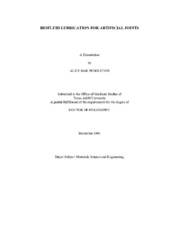| dc.description.abstract | This research investigated biofluid lubrication related to artificial joints using
tribological and rheological approaches. Biofluids studied here represent two categories
of fluids, base fluids and nanostructured biofluids. Base fluids were studied through
comparison of synthetic fluids (simulated body fluid and hyaluronic acid) as well as
natural biofluids (from dogs, horses, and humans) in terms of viscosity and fluid shear
stress. The nano-structured biofluids were formed using molecules having well-defined
shapes. Understanding nano-structured biofluids leads to new ways of design and
synthesis of biofluids that are beneficial for artificial joint performance.
Experimental approaches were utilized in the present research. This includes
basic analysis of biofluids’ property, such as viscosity, fluid shear stress, and shear rate
using rheological experiments. Tribological investigation and surface characterization
were conducted in order to understand effects of molecular and nanostructures on fluid
lubrication. Workpiece surface structure and wear mechanisms were investigated using a scanning electron microscope and a transmission electron microscope. The surface
topography was examined using a profilometer.
The results demonstrated that with the adding of solid additives, such as crown
ether or fullerene acted as rough as the other solids in the 3-body wear systems. In
addition, the fullerene supplied low friction and low wear, which designates the
lubrication purpose of this particular particle system.
This dissertation is constructed of six chapters. The first chapter is an
introduction to body fluids, as mentioned earlier. After Chapter II, it examines the
motivation and approach of the present research, Chapter III discusses the experimental
approaches, including materials, experimental setup, and conditions. In Chapter IV,
lubrication properties of various fluids are discussed. The tribological properties and
performance nanostructured biofluids are discussed in Chapter V, followed by summary
and conclusions in Chapter VI. | en |


